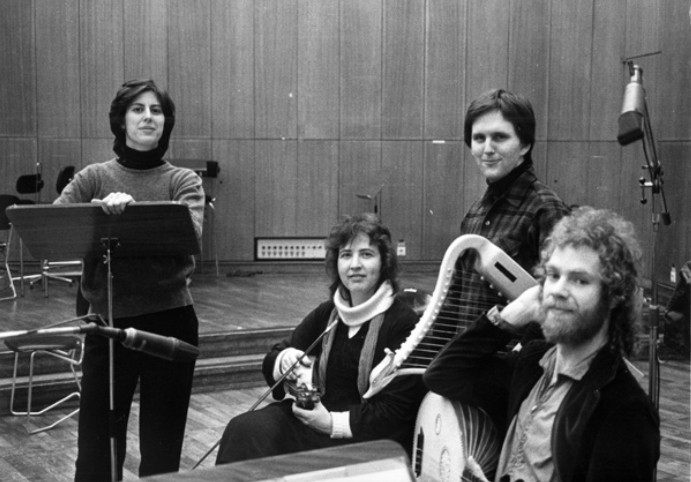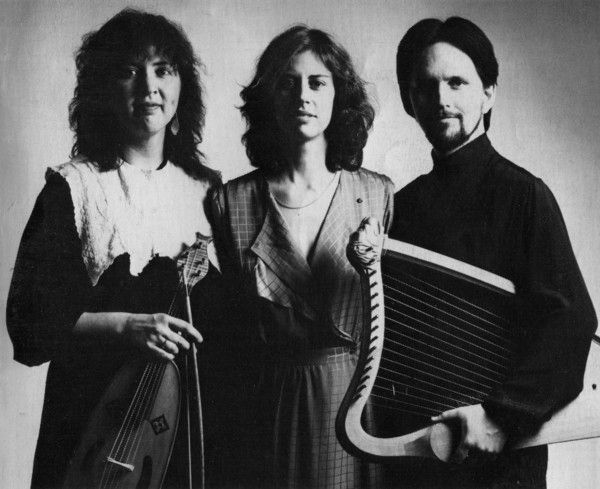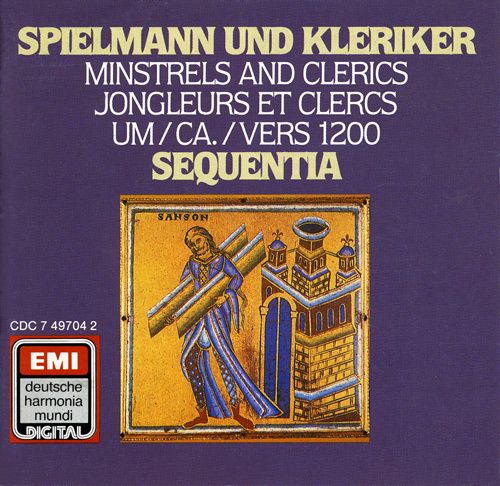
medieval.org
sequentia.org
Deutsche Harmonia Mundi (EMI) 1C 067-99 921 T (LP)
1981
CD, 1988 — Deutsche Harmonia Mundi (EMI) CDC 7 49704 2

medieval.org
sequentia.org
Deutsche Harmonia Mundi (EMI) 1C 067-99 921 T (LP)
1981
CD, 1988 — Deutsche Harmonia Mundi (EMI) CDC 7 49704 2
1. Olim sudor Herculis [10:08]
Firenze, Bibl. Laur., Plut. 29.1, fol. 417
Sänger, Sängerin, Gittern, Fidel |
2 voices, gittern, fiddle
2. Lai du Kievrefuel [11:53]
Paris, Bibl. Nat., fr. 12615, fol. 66
Sängerin, Fidel |
voice, fiddle
3. Lai Markiol [6:39]
Paris, Bibl. Nat., fr. 12615, fol. 72
Fidel, Harfe |
fiddle, harp
4. Lai des Amans [14:29]
Paris, Bibl. Nat., fr. 12615, fol. 69
Sängerin, Fidel, Harfe, Laute |
voice, fiddle, harp, lute
5. Samson dux Fortissime [14:27]
London, Brit. Mus., Harley 978, fol. 1
Sänger, Sängerin, Fidel, Gittern |
2 voices, fiddle, gittern

SEQUENTIA, Ensemble für Musik des
Mittelalters
Ensemble for Medieval Music
Barbara Thornton — Gesang | voice
Benjamin Bagby — Gesang , Harfe | voice, harp
Margriet Tindemans — Fidel | fiddle
Crawford Young — Laute, Gittern | luth, gittern
Instrumentarium:
5saitige Fidel von / 5-string fiddle by Fabrizio Reginato (Fonte Alto, Italien / Italy ) 1978
Bogen von / Bow by D.R. Miller (Boston, USA) 1980
15saitige Harfe von / 15-string harp by Alan Crumpler (Leominster, England) 1979
4chörige Gittern von / 4-course gittern by Fabrizio Reginato (Fonte Alto, Italien / Italy ) 1973
4chörige Laute von / 4-course lute D.R. Miller (Boston, USA) 1980
4saitige Gittern von / 4-string gittern by Guy Biechele (Boston, USA) 1979
Aufgenommen / Recorded : Cedernsaal, Schloß Kirchheim
Dr. Thomas Gallia • Klaus L Neumann Paul Dery
Technik / Techinical equipment : harmonia mundi acustica
Titelbild: Samson trägt die Tore von Gaza (emaillierte Schmuckplatte, 12. Jh. Mosan)
Front cover: Samson carries the gates of Gaza (enamelled decoration plate, 12th century, Mosan)
Mit freundlicher Genehmigung von / By kind permission of The Trustees of the British Museum
Gestaltung Vorderseite / Front cover design: B & M Wiesinger
EMI Records Ltd.
Eine Co-Produktion mit dem Westdeutscher Rundfunk Köln WDR
CD: ℗ 1981 harmonia mundi / © harmonia mundi, 1988
Recorded June 1980 in the Zedernsaal of Schloß Kirchheim (D).
Released 1981 as LP by Deutsche Harmonia Mundi in coproduction with WDR Köln
and 1988 as digitally remastered CD by EMI (CDC7497042). —
sequentia.org

MINSTRELS AND CLERICS c. 1200
Breton Lai · Latin Heroic Lai · Sequence
The title of this recording focuses on an important underlying aspect
of medieval, and especially 12th-century, musical life: the interaction
between two seemingly opposed groups of musicians, the clerics of the
church and the professional secular minstrels. The conventional modern
view of music in medieval Europe often makes a simplistic distinction
between, on the one hand, the secular world of the travelling minstrel,
who sang of erotic love and politics before noble audiences in castle
halls, accompanied by a wide variety of instruments, and, on the other
hand, the hermetically sealed world of church music, where priests,
monks and nuns devoted themselves to a ritual music of praise and
devotion, looking upon minstrels, love songs and musical instruments as
works of the devil.
In fact, these two worlds had much in common. The courtly minstrel (Old
French, jogelor; Middle High German, Spîlman) and
the clerical musician (Latin: clericus, referring to all
clergy, with the term cantores applying to liturgical vocal
soloists) shared not only a love of music and poetry, but a vast
repertoire of melodies, song-forms, instruments, and instrumental/vocal
techniques as well.
But how and where did these worlds intersect? As with any investigation
of medieval life, we must piece together the whole picture from
tantalizing bits of evidence. For instance, we know that in the
12th-century, monasteries were recruiting increasingly among young
adults of noble birth, as opposed to the earlier custom of accepting
young children as oblates. This means that many novices,
especially those of noble birth, would have come into the cloister with
a prior experience of tournaments, courtly entertainment, secular love
poetry and music. In addition, we know that several of the Occitan
troubadours spent the winter months in monasteries, composing new cansos
of love; and from these same monasteries, especially those in
Aquitaine, came the 12th-century flowering of monophonic and polyphonic
versus, masterpieces of the cantores' art. We even find
secular musicians employed by members of the Church hierarchy, those
bishops and abbots of noble birth whose tastes in music, as well as in
politics, were more worldly than we might think. Medieval English
payrolls inform us, for instance, that certain bishops and abbots had
their own private minstrels. The Bishop of Durham once attended a royal
festivity in the company of his two "harpours". Finally, we find an
entire repertoire of simple clerical songs from the so-called
Notre-Dame School of the late 12th century, which were probably
intended for group singing, playing, and even dancing on special
feast-days.
The list of such examples could go on and on. As we examine the
"Renaissance of the 12th-Century", there begins to emerge a picture of
great flux and exchange between the musical spheres of court and
church. For this recording, we have chosen larger lyric forms, common
in northern Europe, such as the sequence and the lai, forms
which served the singer of courtly love, the instrumentalist, as well
as the cantores of the church.
The Music
Olim sudor Herculis
This classical sequence, with its anti-love text, originates from the
court of Henry II and Eleanor of Aquitaine, overlords of the vast
12th-century Angevin Empire. It is likely that such a piece would have
been known in a clerical milieu as well. There are some indications
that the refrain, which is not normally an element of a sequence, can
be sung after each half-stanza. Our performance recreates the piece as
it would have been enjoyed by musical and literary cognoscenti,
both courtly and clerical, during an evening's entertainment.
Reflecting contemporary musical practice in the church, some sections
are sung in free rhythm over a sustained tone, while others are
strictly rhythmic, and follow the rules of discantus, or
improvised counterpoint. The well-known refrain melody is sung and
played by all those present, with each musician helping to create a
polyphonic elaboration of the melody.
Lai du Kievrefuel
Lai Markiol
Lai des Amans
Marie de France, a noblewoman who probably lived at the court of Henry
II and Eleanor of Aquitaine in the late 12th-century, relates how she
came into contact with Breton lais, those exotic love-stories
which were sung and played by Breton minstrels visiting the court.
These lais, which are lost to us today save in Marie's French verse
translations, have evocative titles such as "Equitan", "Les deus
amanz", "Eliduc", and "Chevrefoil". From contemporary sources, we know
that Breton lais were an important form of courtly
entertainment. Even that paragon of courtliness, Tristan, knew them
well, as he tells his Isolde: "Bons lais de harpe vus apris / lais
bretuns de vostre pais ..." ("I have taught you good lais to the harp,
Breton lais of your own country..."). Unfortunately for posterity, the
melodies to these Breton lais were passed orally from musician
to musician, and probably never written down. The pieces recorded here
are written lais which have similar titles to the pieces Marie
describes, but whose sophisticated love texts are not specifically
Breton. These anonymous lais, with curious titles —
"Kievrefuel" ("honeysuckle"), "Markiol" and "des Amans" — are
composed of repeating melodic cells of various lengths, corresponding
to the complex poetic structure of the text. The melodies were possibly
never "composed" in the modern sense of the word, but rather came from
an oral tradition, which, if not specifically that of Marie's Breton
harpers, was certainly influenced by the strong imprint they left on
northern European musical culture.
For this recording, we have taken three lais from the same manuscript
collection, and given each of them a different mode of performance.
First, in the "Lai du Kievrefuel", we hear an intimate rendering, in
which the singer and the instrumentalist work together carefully to
emphasize and clarify the structure of this lai which is "sweeter than
honey". The combination of the voice and one instrument was a favoured
manner of performance in the 12th-century. The second lai, "Markiol",
is given a purely instrumental rendering, a practice known as playing
the note ("note" or "melody") of the lai. That this was
commonly done is illustrated in many contemporary sources, such as the Roman
de Flamenca:
L'uns viola lais de Cabrefoil,
E l'autre cel de Tintagoil;
L'us cantet cel dels Fins Amanz,
E l'autre cel que fes Ivans.
L'us menet arpa, l'autra viula;
L'us flütella, l'autre siula;
L'us mena giga, l'autre rota;
L'us diz los motz e l'autrels nota
(One fiddled the lai of Kievrefuel,
and the other that of Tintagel;
one sang that of Fins Amanz,
and the other the lai that Ywain made.
One played a harp, the other a fiddle,
one played a flute, the other a whistle;
one had a giga [a type of fiddle], the other a rota;
one delivered the words, and the other the melody...)
The "Lai des Amans" is given a performance such as one would hear at a
courtly celebration, wedding or knighting ceremony, when many minstrels
had gathered. The four musicians, each of whom knows the lai,
come together on this occasion for a festive rendering — a real
"performance".
Samson dux fortissime
The story of the Old Testament hero Samson (Judges 14-16) is
dramatically told in this composition, which has a lai
structure. Here, as in the Breton lais, repeating melodic cells
in various combinations build up to form a large musical structure.
Although the exact provenance of the piece is not clear, it probably
came from a clerical milieu, where it would have served as ennobling
entertainment. For our performance, we have assumed a formal
surrounding, such as a bishop's palace, where the bishop's personal
minstrels join with clerical musicians versed in discantus singing. As
a prelude and postlude to the dramatized performance, the instruments
play a polyphonic composition found in the same manuscript as the lai
itself.
© Benjamin Bagby, 1981

The Texts
The two Latin compositions
The twelfth century saw new heights of achievement in two cognate
poetic-musical forms that are first attested in manuscripts of the
ninth century: the lyrical lai and the sequence. From the
earliest times, both forms were used for vernacular as well as Latin
compositions, for profane as well as sacred themes. Where the classical
sequence was composed basically in symmetrical pairs of half-strophes,
sung to the same melody, with a new melody for each new pair, the
lyrical lai could employ both more complex and freer strophic
groupings.
Our evidence about the performance of the (lost) Breton lyrical lais
strongly suggests that their poetic and musical form was closely
similar to that of their Latin counterparts. The Latin lai, not
widely attested between the ninth century and the twelfth, emerges
again as a high art form in the cycle of laments (planctus)
composed in the 1130s by Peter Abelard (1079-1142). Abelard, a Breton
by birth, will have absorbed the melodies of vernacular Breton lais
during his youth and been inspired by them (even though he was not
himself Breton-speaking).
Samson dux fortissime
One of the laments in Abelard's cycle is that of Israel over the death
of Samson. This piece will have been known to the anonymous author of Samson
dux fortissime, who planned his composition almost, we might say,
as a riposte to Abelard's. Where in Abelard the chorus was the Jewish
people, who could see in Samson's death only a tragic waste, a suicide
bred of despair, the close of the new piece (composed perhaps in
northern France in the later twelfth century) shows the chorus, or
commentator on the events, proclaiming Samson's death a victory and a
glory. Implicit here is the Christian figural interpretation, by which
Samson, suffering and dying and delivering his people, foreshadows
Christ.
The text survives in three manuscripts of the thirteenth century, one
Anglo-Norman and two German. It is corrupt in all of these, but the
Anglo-Norman one, which contains the melody as here performed, can be
corrected with the help of the other two. One of the German manuscripts
makes clear by a rubric that the piece was dramatic in intention: it
indicates that Dalila must sing the words ascribed to her. Yet the
drama is far from naturalistic: the poet uses an astonishing freedom of
time-sequence. Dalila enters and recedes each time as if she were a
phantom, an intense projection of Samson's own memories: musically it
is noteworthy, for instance, that her melody of victory (in st. 14)
echoes note for note his melody of defeat (in st. 12). Near the close,
too, as Samson describes his act of vengeance, naturalistic time is
suspended, so that he is able to tell his victory as if he had survived
it (which the Bible explicitly denies).
Olim sudor Herculis
This song, a classical sequence with refrain, is a virtuoso composition
in its strophic forms, rhymes and word-play. It alludes lightly to the
ancient myth of the twelve labours of Hercules, and laughingly
contrasts his fortitude in these with his susceptibility in love. The
author, Peter of Blois (ca. 1135 —1212), had a cosmopolitan
career as courtier and scholar, and became secretary to Henry II of
England and Eleanor of Aquitaine. In recent scholarship, Peter has come
to be recognized as one of the leading twelfth-century lyrical
composers. In a study of his poetry (in the journal Medieval Studies,
1976), I argued for a canon of some fifty lyrics that are probably by
Peter, and many of these survive with their melodies. Some, such as Olim
sudor Herculis, will have been performed not only at Henry and
Eleanor's court but also (as the occurrence of this song in one of the
major manuscripts from Notre Dame of Paris shows) as entertainment in
the scholastic world, in the more sophisticated cathedral schools. The
theme of this sequence is characteristic of Peter's lyrics: again and
again he writes witty, playful palinodes, claiming that he has rejected
— or is just about to reject — the lures of sensual love,
or of courtly frivolities, that he has turned over a new leaf. Yet the
claim is never made decisively: Peter loves repenting — and
gazing back at what he is repenting of.
Here he resolves to abandon love, and asks his fictive beloved,
Lycoris, to do so too: yet not because God is displeased by a sensual
way of life, but for a worldly reason: 'Love deflowers fame's merit',
and Peter wants to become famous. He is amazed that Hercules (whose
name was often at this time thought to mean 'fame of heroes') was so
weak, allowing his heroic reputation to be tarnished; yet between the
lines Peter slyly hints that for Hercules it was worth it to give up
all for love. And when he ends, 'I'm stronger than Hercules, for look,
I'm running away!' the note of irony and self-mockery is unmistakable.
© Peter Dronke, 1981
Breton lais
The lai of Chevrefoil ("honeysuckle") is the title of one of
the Breton lais set by Marie de France, which recounts an
episode from the Tristan and Isolde legend: a branch of honeysuckle was
used as a signal between the lovers in the woods where they were to
meet in secret. Marie says that in remembrance of that meeting, Tristan
composed a lai called Chevrefoil. The musical version presented
here, which shares only its title with Marie's Breton lai, is
earnest and sweet in its tone and imagery, making a lover's sentiments
believable. Likewise, Marie retells the lai of Les Deus
Amanz, based on the old legend about two noble young lovers in
ancient Normandy, whose headstrong passion leads only to their sad
deaths on a mountaintop. In the musical version, Lai des Amans,
the poem tells no story, but rather fascinates the listener with its
skilled and playful composition of rhyme, sound and sentiment,
revealing a courtly poet of inventiveness and refinement.
© Barbara Thornton, 1981
